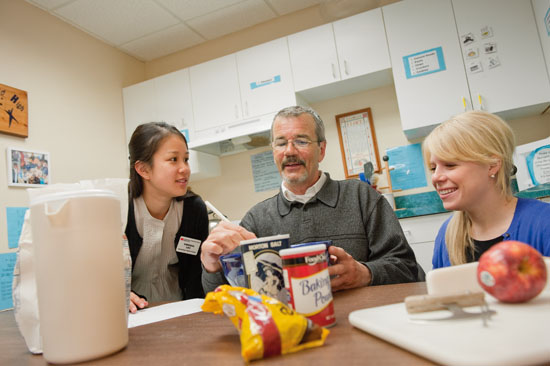Giving Back to Boston
SAR grad students volunteer at community groups

It sounds like a typical conversation between friends. “I had a really bad day today,” says one girl. “What happened? Can you tell me about it?” the other responds.
But there was nothing ordinary about this particular exchange, which occurred at an after-school program for adolescents with developmental disabilities in Hyde Park. The young woman showing concern had a history of behavioral challenges, including an unwillingness to participate with others. That she reached out to another person “is just one example of how we saw an improvement in members of our group,” says Carolyn Rosca (SAR’09,’11), a Sargent College graduate student who along with Danielle Angueira (SAR’11) planned and ran a group at TILL (Toward Independent Living and Learning) Trase designed to improve social interaction in high-functioning young people from 12 to 21.
This encouraging exchange is just one indication of the impact of SAR occupational therapy students in the Group Leadership Experience (GLE) program. During their final semester, students team up, usually in pairs, to colead a weekly occupational therapy group in a community setting, enabling them to implement all they’ve learned in the master’s program. “We had 47 students in 23 settings during spring 2010,” says Ellen Cohn (SAR’76,’00), a SAR clinical professor. “It’s a capstone experience for them. The students develop a tremendous sense of competence and self-efficacy because they see that they can design an intervention and lead a group.”
They worked in groups of 2 to 15, with people of all ages in a variety of locations and programs. Two students worked on social interaction with a group for adolescents with an autism spectrum disorder, exploring the Museum of Science. Another pair volunteered at the East Boston after-school program Let’s Get Movin’, working with 8- to 10-year-olds at risk for obesity. At an inpatient rehabilitation center, students used a combination of sports and trivia questions to address the physical and cognitive needs of adults who had had a stroke.
“The clients who participate in these groups greatly benefit from them,” says Cohn. “They are able to make some changes in the way they structure their daily life. The agencies benefit as well, because the students are providing a very structured group experience. It’s theory-driven and evidence-based. The supervisors receive a copy of their group protocols, and the community agencies can, and sometimes do, replicate the protocol to run the group themselves.”
 At TILL Trase, Rosca and Angueira worked with up to eight adolescents with disorders and conditions that included Down syndrome, autism, and psychosocial difficulties. They decided to focus on social interaction skills, a specific function each week, such as maintaining eye contact, initiating conversation, and teamwork. “We used cooking as our theme,” says Rosca. “We decided to do healthy snack preparations, because a lot of them also have weight problems. As they were learning cooking skills, they were also learning social interaction skills.”
At TILL Trase, Rosca and Angueira worked with up to eight adolescents with disorders and conditions that included Down syndrome, autism, and psychosocial difficulties. They decided to focus on social interaction skills, a specific function each week, such as maintaining eye contact, initiating conversation, and teamwork. “We used cooking as our theme,” says Rosca. “We decided to do healthy snack preparations, because a lot of them also have weight problems. As they were learning cooking skills, they were also learning social interaction skills.”
Rosca was learning, too, she says. “Our biggest challenge was appropriately responding to the students without being condescending,” she says. “Eventually, I realized that you just talk with them, so I learned how to interact with them on an age-appropriate level.
“Danielle and I didn’t know what their diagnoses were when we started—that turned out to be a good thing, because we didn’t have any preconceived notions. We got to know them on an ability level, rather than from a piece of paper. That was a very valuable lesson.”
Vanessa Lau (SAR’09,’11) and Jennifer Grasso (SAR’09,’11) also used a cooking theme, but their group’s population was different and they had a different purpose. Lau and Grasso ran an open group, usually with three or four adults attending each week, at Community Rehab Care (CRC) in Quincy, an outpatient clinic for people with brain injuries. “They were at different levels,” says Lau, “so Jen and I had to plan a lot to figure out how to challenge those with a higher cognitive capacity and those with a more severe impairment.”
Their cooking sessions encompassed money management, grocery shopping, and planning and making a meal. “Planning is something that this population has trouble doing,” says Lau.

CRC supervisor Ariel Zwelling (SAR’09) (above) says that what the SAR GLE students do at her facility is important. “The students are teaching real-life skills, things these clients need to be doing for themselves every day,” she says. “So it has an impact. And the students get so much out of it, too. I think Vanessa and Jennifer both grew in terms of confidence.”
Cohn says that one of the great joys of the program for her is watching students blossom in perhaps unexpected ways. “Sometimes students who may not be the strongest in the academic environment shine in front of a group. They have great interpersonal skills, or they’re very in tune to clients,” she says. “There’s always this serendipitous learning that emerges from the situation of practice.”
This article originally appeared in the 2010–2011 issue of Inside Sargent.
Comments & Discussion
Boston University moderates comments to facilitate an informed, substantive, civil conversation. Abusive, profane, self-promotional, misleading, incoherent or off-topic comments will be rejected. Moderators are staffed during regular business hours (EST) and can only accept comments written in English. Statistics or facts must include a citation or a link to the citation.